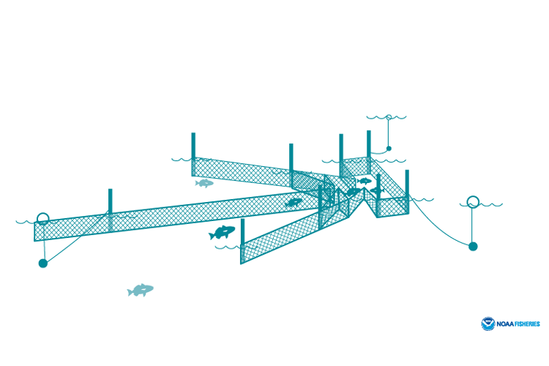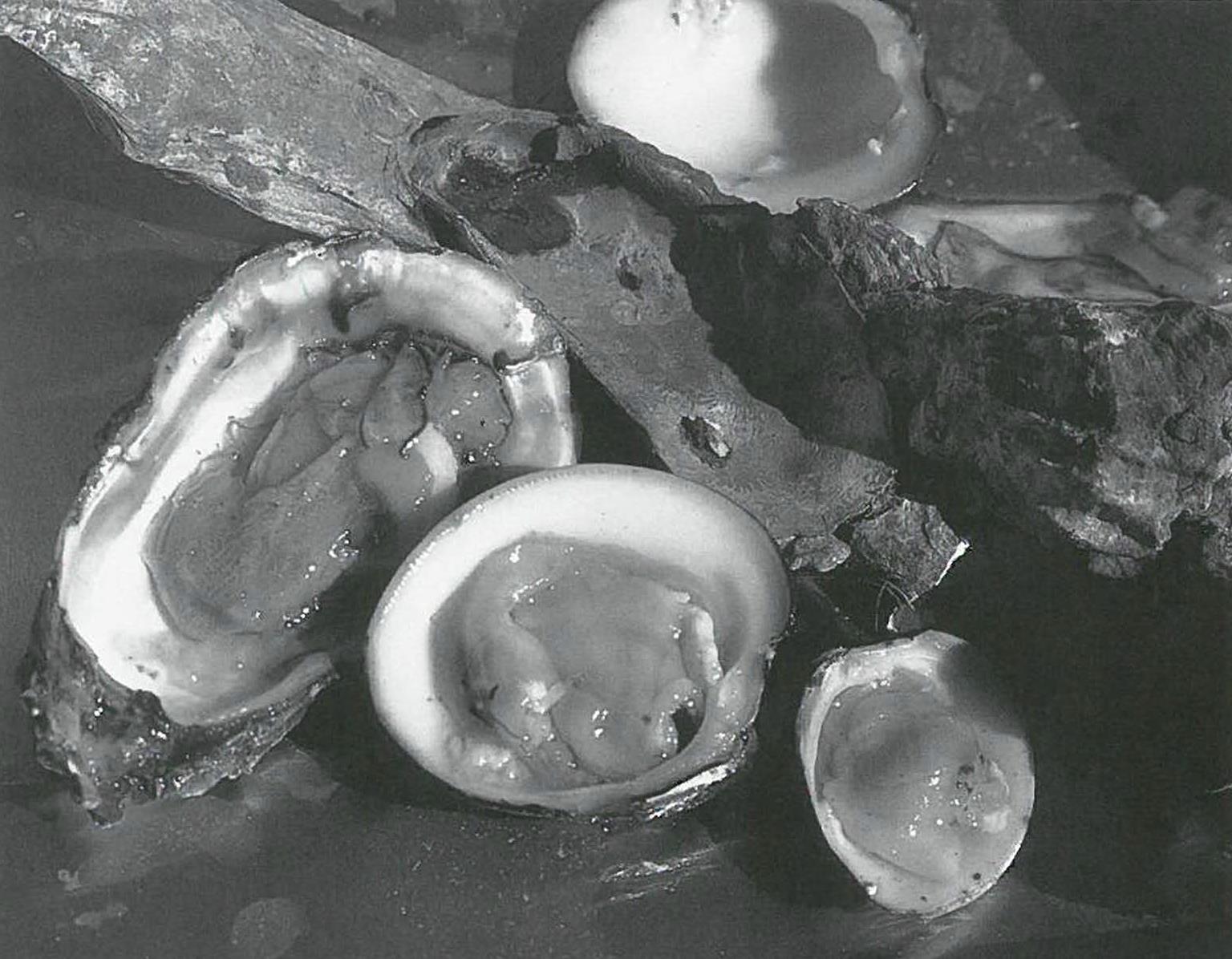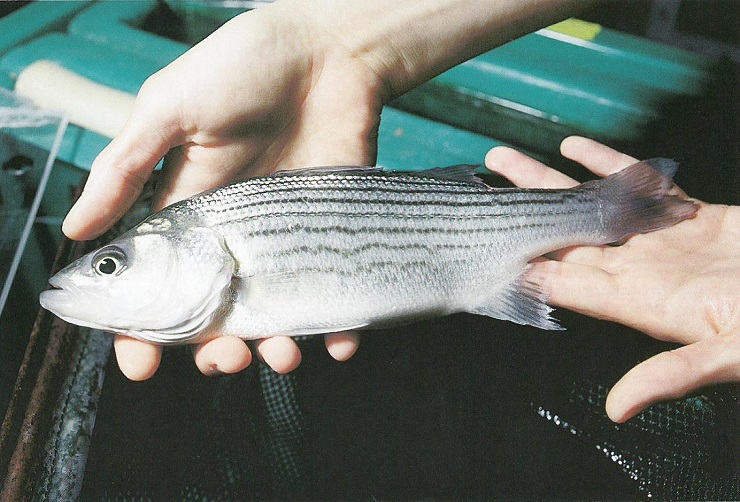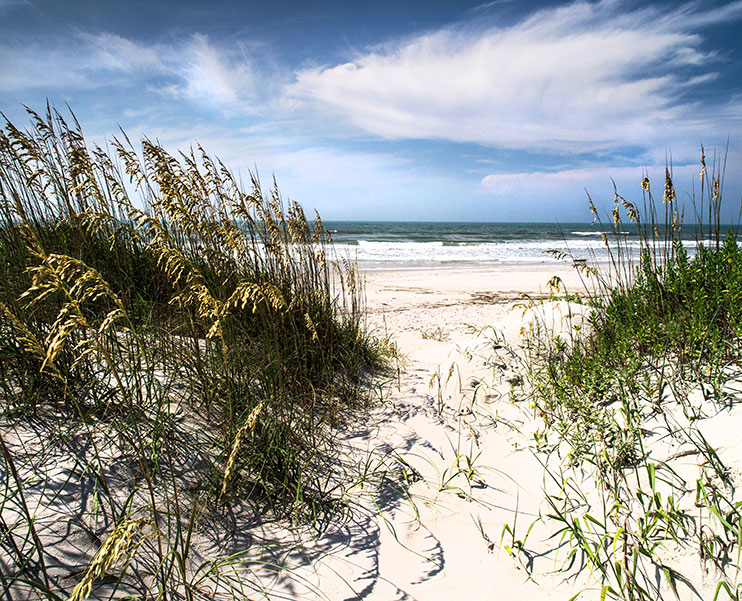Pound Netting: Rich Fishing Tradition Seeing Decline

As Mike Peele guides his old shad boat through the middle of the Pamlico Sound, the water is so smooth he sets the automatic pilot.
Standing toward one side of the boat, Peele spots a group of white poles and moves back to the steering station to slow the engine. With one hand on his knee and the other on the steering wheel, he maneuvers the boat into the middle of a huge maze of fishing net.
“I just put on a new propeller,” says Peele. “The engine is like a sailboat — slow and easy. I will be working two nets. If the wind’s blowing 30 mph, you can put 10,000 pounds of fish in the gunwale.”
After anchoring almost four miles behind Hatteras Island, Peele slips a pair of rubber gloves on his hands and green overalls over his tank-style T-shirt and shorts. Immediately, he and his fishing partner, Jeff Kennedy, tie the net to the side of the boat and pull it in so tight that the area is closed off.
“This is called bunting or pursing up — forcing the fish on one side,” says Peele. “Pound netting is the safest way to fish. You get all live catch and can sort through what you don’t want.”
To recover the catch from the pound net, both fishers use dip nets. Peele pulls up a few wiggly fish, including a pompano, butterfish and a five-pound flounder.
“This is a pretty one,” he says while holding up the flounder. “The biggest flounder I ever caught was 10 pounds.”
A muscular, middle-aged man with several tattoos on his arms, Peele is the fifth generation of his family to set pound nets for flounder each fall in the Pamlico Sound.
“I was probably 10 when I started doing pound nets with my father and Uncle Nacie Peele,” he says.
After Mike’s dad died, Nacie continued to fish. On a recent day, the colorful 82-year-old had caught about nine pounds of flounder.
“I have been fishing for 68 years,” says Nacie. “I fish every day. The best fishing is with a pound net.”
Nacie collected his first paycheck for fishing when he was 13.
“For my first paycheck, I pulled in 5,000 pounds of flounder and got half of the price — or $13,” he says.
Fellowship Among Fishers
There is camaraderie among Hatteras Island fishers. Young guys help old-timers when they need a hand and vice versa. They even borrow each other’s boats when one has a broken part.
While in the middle of Pamlico Sound, Mike Peele stops and chats with Wayne Basnett who is checking his net. Basnett has been fishing for flounder since 1957.
“I will come and help you,” says Peele. “You need to raise up the pound.”
For the Peeles and other fishers on Hatteras Island, flounder season starts in early September when they set their nets in permitted spots in the sound.
“There is a lot of work involved in setting nets,” says Mike Peele. “You have to go in the woods and cut the wood for the poles and then tote it out. Now you have modern technology to take the wood down. But you used to have to cut trees down. You can envision how much work it was in the old days.”
Fishers also have to dip nets in a copper solution to reduce the growth of marine organisms, including barnacles. They spread the heavy nets out to dip them and then lift them up with a large crane rigged on the back of a ‘boom’ truck or old pickup truck.
At Cedar Island in Carteret County, they celebrate the hard work of fishers with a boom truck parade in the winter.
“They have between 15 to 18 trucks,” says Joey Gilgo of Atlantic, whose truck is in the parade. “Trucks are painted up every imaginable way — from nets hanging from the booms to clam cages painted on.”
Passive Gear
Although the pound net is tedious to set up, it is an efficient way to catch fish, according to Jim Bahen, North Carolina Sea Grant fisheries specialist. “Pound netting is considered passive gear because fish are led into it. All fish are caught alive. You can throw back what you don’t want.”
In North Carolina, the North Carolina Division of Marine Fisheries (DMF) requires a 5 1/2-inch mesh escape panel in all flounder pound nets except those in the western Albemarle Sound, allowing flounder 12 inches long and less to get out.
Pound nets also do little harm to the turtle population, fisheries officials say.
In random sampling of pound netters in Pamlico Sound as far north as Avon and south to Core Sound and Back Sound behind Harkers Island, the National Marine Fisheries Service (NMFS) found that the fishers caught more than 250 turtles alive during fall 2001.
“There is little turtle mortality associated with pound nets because the turtles can come to the surface to breathe and rarely become entangled in the nets,” says Joanne McNeill, NMFS fishery biologist in Beaufort. “In the fall as turtles migrate out of the sound, they are incidentally captured in pound nets. Also, some loggerheads enter the pound nets looking for a source of food.”
However, pound nets have one drawback — the maze of poles can be a navigational hazard for boaters who aren’t aware of them, according to North Carolina Sea Grant fisheries specialist Bob Hines.
In North Carolina, pound nets are used to catch flounder in Currituck, Albemarle and Core sounds and also in the Pamlico Sound — from Hatteras Island to Hyde County and south to Carteret County. Fishers also use this traditional gear for summer flounder, gray trout and Spanish mackerel in the Pamlico Sound, as well as for river herring in the Chowan River and Albemarle Sound.
Over the past five years, the number of North Carolina permits for pound nets has dropped significantly across North Carolina from 965 in 1995 to 634 in 2001, according to the DMF.
“During the 1990s, fishermen began to switch from pound nets to gill nets,” says David Taylor, DMF fisheries section chief. “Gill nets are easier and cheaper than pound nets and don’t require permits.”
Taylor also attributes a decline in permits to the consolidation of nets and fewer ‘block nets.’
“Fishermen used to put up block nets around other nets so the migration of fish wouldn’t be obstructed,” he adds. “They have gotten rid of some of the block nets.”
River Herring Fisheries
One of the biggest declines in pound net permits has been in Chowan County where the number of nets dropped from 122 in 1995 to 67 in 2001, according to DMF.
“The number of nets has dropped because of harvest quotas on herring that was put in effect in 1995,” says Sara Winslow, DMF northern district manager.
Prior to 1995, there were no restrictions on river herring. However, quotas were set in 1995 to let the stock rebound because of overfishing and adverse environmental conditions as well as pollution and runoff to ditching. Also, the draining of the Chowan River’s tributaries for agriculture destroyed some herring spawning grounds.
In 2000, the N.C. Marine Fisheries Commission adopted a Fishery Management Plan for river herring to protect herring stock. The plan limits the commercial herring fishery to 300,000 pounds per year for the entire state. That total allowable catch is divided into three portions: 200,000 pounds for the pound net fishery on the Chowan; 67,000 for gill nets in the Albemarle Sound herring management area; and 33,000 pounds that the DMF director can assign.
Winslow says it will be a number of years before the herring fisheries recovers. “It will take three to five years for the fish produced in 2000 to reach sexual maturity,” she says.
The number of pound nets in Carteret County also dropped, from 309 in 1995 to 166 last year.
The only area where pound net permits have not dropped significantly is along the Outer Banks. In Dare County, the number of permits declined slightly from 118 in 1995 to 100 last year.
“There are probably 15 to 20 pound netters left on Hatteras Island,” says Mike Peele. “When my father and I did pound netting, there were probably 30 or more.”
In Carteret County, there are a number of pound netters who fish the Pamlico and Core sounds.
For more than 25 years, Gilgo has set his nets in Pamlico Sound.
“Pound netting has been good this year except the price is the lowest in 15 years,” according to Gilgo, in an interview last fall. “I caught 3,000 pounds in one day.”
But, he does not plan to set pound nets in fall 2002.
“I set five nets this year,” he says. “I am getting out of it. I am 57. It takes a toll on your back. You have to go out in rough weather. It takes a special breed of person to pound net because it is so strenuous.”
Old Fisheries
Pound netting has a strong heritage in North Carolina. In 1869, pound nets were introduced into the Albemarle Sound and revolutionized fishing, according to the N.C. Maritime Museum. One account tells of an individual who pulled in one million herring in a single night in 1890 using a pound net.
In February or early March, fishers set pound nets for river herring in the Albemarle Sound and Chowan River.
Herbert Byrum and his brother, Bobby, are the only river herring fishers left at Cannon’s Ferry on the Chowan River in Tyner.
“There used to be 20-something fishermen at Cannon’s Ferry,” says Herbert Byrum.
Byrum’s fish house, which has an American flag flying in the front, is on the banks of the Chowan River.
As you walk down the pier, you can smell cheese used for catfish bait and shrimp used for crab bait.
“We went from making $40,000 a year for herring to $10,000 a year,” says Byrum. “Now, we crab and catfish to make up the difference.”
On his dock, Byrum shows his 20-foot boat used for catching herring. When it’s full from gunwale to gunwale, it holds up to about 4,000 pounds of river herring. The striped bass go back over the side.
“In the heyday in the ’60s, ’70s and ’80s, we would catch 10,000 pounds of herring a day,” he says.
Now, fishers are allowed to catch only 200,000 pounds for the whole season in the Chowan River, adds Byrum.
On a recent day, Byrum, who has been pound netting since he was a high school student in the 1960s, leaves the dock and heads out into the muddy river. He stops in an area where the wooden stakes are shaped like a heart. The fish swim into the heart of the net along a lead set near the shore.
“Pound netting is beautiful fishing,” says Byrum. “It gets in your blood. It is hard work and exciting. If you pull up a net with 5,000 to 10,000 pounds of fish, it is a pretty sight. On some days, we release 6,000 to 7,000 pounds of rock fish a day,” he says.
Along the river, there are a few remnants of when herring fisheries dominated the area.
Some of the wooden pilings of an old fish house, which collapsed during a 1993 northeaster, lean into the water.
“That was where they processed herring,” he says. “You used to pull the boat up in the middle. The fish ran up a big washer, scale and cutting bench. There would be 100 women cutting heads and guts of fish.”
The decline of the herring fisheries forced Walt Jeffreys to relocate to Buxton.
“I pound netted on the Chowan River until 1985 when herring left,” says Jeffreys. “Trouble came with the river flooding in ’82 and ’83. When I was a boy, we used to say herring ran in 30-year cycles. Had bumper crops from 1955 to 1982. We used to ship as high as 90,000 pounds of herring a day.”
When Jeffreys moved to Buxton, he switched to flounder fishing. Until his brother died a few years ago, the two fished as a team. Now, Jeffreys has another worker.
“I’ve got six flounder rigs,” he says. “I fish in water 14 to 18 feet deep.”
Occasionally, Jeffreys’ grown daughter, Heather Glisson, helps him.
“I like pound netting,” says Glisson. “It is different.” However, Glisson doesn’t want to fish for a living. “It is too hard,” she adds.
Jeffreys is tired of fishing, and says he wouldn’t go into the business if he were starting out today. “It is like family farms,” he says.
“Only big time fish places, like in Wanchese, can survive.”
This article was published in the Winter 2002 issue of Coastwatch.
For contact information and reprint requests, visit ncseagrant.ncsu.edu/coastwatch/contact/.
- Categories:


